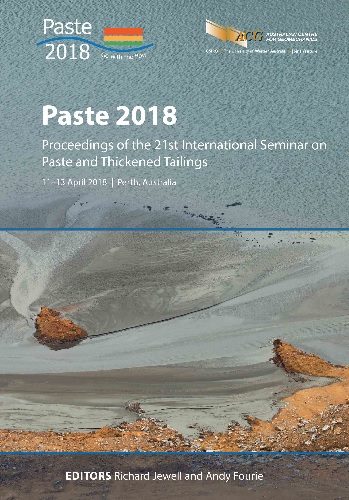How thick is thick enough?

|
Authors: Munro, LD; Smirk, DD |
DOI https://doi.org/10.36487/ACG_rep/1805_01_Munro
Cite As:
Munro, LD & Smirk, DD 2018, 'How thick is thick enough?', in RJ Jewell & AB Fourie (eds), Paste 2018: Proceedings of the 21st International Seminar on Paste and Thickened Tailings, Australian Centre for Geomechanics, Perth, pp. 23-34, https://doi.org/10.36487/ACG_rep/1805_01_Munro
Abstract:
The increasingly stringent regulatory controls and limitations placed on tailings operations to minimise their contaminated and/or operational footprint commonly leads to the simplest of conclusions being reached. That is, to ensure the success of the tailings storage facility (TSF), the density of tailings must be maximised at the point of discharge. The pursuit of higher discharge density began in the 1980s with the development of deep cone thickeners and advanced polymers. From this point, there were additional developments in filtration and centrifugation. However, as technology has developed and various issues endure, it is prudent to ask the key question – how thick is thick enough? While it is generally accepted that a TSF undergoing closure should be of high density and strength to permit flexible closure options, this does not mean this can only be achieved with a high tailings discharge density. The TSF designer’s goal is to ensure alignment between project obligations and constraints to deliver the desired endpoint. Importantly, the cost of tailings management includes not only the TSF but the tailings conditioning technology and, ultimately, closure. Additionally, tailings processing technologies that deliver paste and cake may not be specifically mandated by project constraints. Mud farming, or accelerated mechanical consolidation (AMC) supports a smaller TSF footprint without the need to adopt an expensive pre-disposal processing step. AMC techniques offer the potential to achieve high final densities and strengths through enhanced or continued dewatering and consolidation whilst providing a means of managing many post-placement issues that can occur. This approach can be applied at either the design or adopted within the operating stage and is effective in low-density slurries through to high-density pastes. Accelerated mechanical consolidation evolved from the alumina industry and is now in common practice in many other commodities and industries and is orders of magnitude less expensive than its predisposal dewatering counterparts. Following the tailings dam failure at the Mount Polley TSF in British Columbia, Canada, recommendations from an expert review panel (Brett et al. 2015) include the application of the best available technology (BAT) concept. Australian examples of BAT include dry stacking from filter-pressed tailings at Karara (FLSmidth 2012) and by AMC at various sites, particularly in the alumina industry (International Alumina Institute 2014). This type of approach (Munro 2012) could indicate an appropriate way to utilise BAT without the power, maintenance and capital cost, and availability issues of filters. Whilst maintaining an appreciation for the required trade-off between the various project constraints, obligations and operational intent, this paper provides a broad examination of some of the simple controls and perhaps unconventional approaches, such as AMC that can best deliver required outcomes in tailings management. Examples are provided of various large-scale tailings management operations that have optimised their operational footprint, lowered operational costs and maintained timely consolidation for a range of discharge densities and regimes.
Keywords: tailings management, accelerated mechanical consolidation (AMC), mud farming, amphirol, best available technology (BAT)
References:
Bentel, G 2003, ‘Above ground disposal’, in RJ Jewell, AB Fourie and ER Lord (eds), Paste and Thickened Tailings: A Guide, Australian Centre for Geomechanics, Perth.
Brett, D, Longey, R & Herza, J 2015, ‘Abracadabra – the disappearing tailings dam’, Proceedings of the 2015 ANCOLD Conference: Contemporary Challenges for Dams, Australian National Committee on Large Dams, Hobart.
Fitton, TG & Seddon, KD 2013, ‘Paste and thickened tailings – myth busting and clarification’, in RJ Jewell, AB Fourie, J Caldwell and J Pimenta (eds), Proceedings of the 16th International Seminar on Paste and Thickened Tailings, Australian Centre for Geomechanics, Perth, pp. 37–46.
FLSmidth 2012, World Class Tailings Technology for Karara, FLSmidth, Perth, viewed 16 February 2018,
International Alumina Institute 2014, Bauxite Residue Management Best Practice, International Aluminium Institute, London, and European Aluminium Association, Brussels.
Munro, LD, White, RW & Smirk, DD 2014, ‘Post-deposition management – the next step in paste and thickened tailings management’, in RJ Jewell, AB Fourie, PS Wells and D van Zyl (eds), Proceedings of the 17th International Seminar on Paste and Thickened Tailings, InfoMine Inc., Vancouver, pp. 403–416.
Munro, LD & Smirk, DD 2012, ‘Optimising bauxite residue deliquoring and consolidation’, Proceedings of the 9th International Alumina Quality Workshop, AQW Inc., Perth.
Netherton, DE 2017, Conventional Disposal vs. Thickened Tailings Disposal, Tailings Management Systems, South River, viewed 16 February 2018,
Patel, S & Pal, BK 2015, ‘Current status of an industrial waste: red mud an overview’, International Journal of Latest Technology in Engineering, Management and Applied Science, vol. IV, no. VIII, pp. 1–16.
Yao, Y 2012, ‘The effect of flocculent on the geotechnical properties of mature fine tailings’, in D Sego, GW Wilson and N Beier (eds), Proceedings of the 3rd International Oil Sands Tailings Conference, Oil Sands Tailings Research Facility, Calgary, pp. 391–398.
© Copyright 2024, Australian Centre for Geomechanics (ACG), The University of Western Australia. All rights reserved.
View copyright/legal information
Please direct any queries or error reports to repository-acg@uwa.edu.au
View copyright/legal information
Please direct any queries or error reports to repository-acg@uwa.edu.au



